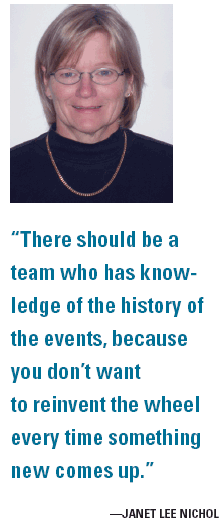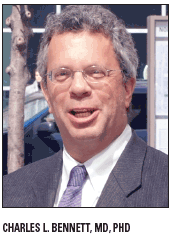Drug-safety experts call for consortium to oversee adverse reactions information
CHICAGO-Serious and fatal drug reactions tripled between 1998 and 2005, according to a 2007 FDA analysis. In that time period, the total number of serious adverse drug events multiplied 4 times faster than the number of prescriptions written. The number of serious drug reactions for biotechnology agents rose nearly 18-fold (T Moore et al: Analysis of FDA reported post marketing ADR database, Arch Intern Med 167:1752-1759, 2007).
CHICAGO-Serious and fatal drug reactions tripled between 1998 and 2005, according to a 2007 FDA analysis. In that time period, the total number of serious adverse drug events multiplied 4 times faster than the number of prescriptions written. Th e number of serious drug reactions for biotechnology agents rose nearly 18-fold (T Moore et al: Analysis of FDA reported post marketing ADR database, Arch Intern Med 167:1752-1759, 2007).
At the 2008 Oncobiotechnology Research, Clinical and Business Summit at Northwestern University, a panel of experts from the biotechnology industry, FDA, and the clinical research setting discussed how all segments of the research community must work together to provide better oversight of drug safety. Addressing the topic of drug safety monitoring, Janet Lee Nichol, an independent biotechnology consultant based in Oxnard, Calif., said the onus was on clinical trial sponsors to review outcomes on an ongoing basis.

“Sponsors of clinical trials need to identify a product-independent, internal group that will review outcomes in an ongoing way so they can look for signals of adverse events before the next safety monitoring period comes up,” she said.
“You don’t want to wait a long period of time and have adverse reactions developing. You want to look for problems with or without the safety monitoring board, and you want the review to be independent both in terms of the product being tested and the company that is testing it.” “You also need to proactively identify the types of outcomes that would be ‘deal breakers,’” Ms. Nichol added. “These are the types of adverse reactions that would cause termination of the drug administration.
It’s much easier to do that before you see events than during a clinical trial program when you actually find them.” Charles L. Bennett, MD, PhD, professor in the division of hematology and oncology at the Feinberg School of Medicine at Northwestern University in Chicago, discussed the university’s Research on Adverse Drug events And Reports (RADAR) project that aims for an independent, systematic review of adverse reactions.
“RADAR investigates reports of serious adverse reactions made by hematologists and oncologists throughout the world, analyzes the data from those investigations, and publishes the results in peer-reviewed journals,” Dr. Bennett said, citing examples of how RADAR tracks serious drug reactions.
“In one case, RADAR investigators found 13 cases of thrombotic thrombocytopenic purpura (TTP) in patients who took clopidogrel (Plavix),” he said. “In that work, we set up a consortium of blood banks that would call us as soon as someone showed up with TTP so we could see if the patient took clopidogrel. Within three months of having all these blood banks on alert, we got 11 calls and found that all 11 people had taken clopidogrel. Within six months, we had a signal that the drug was related to TTP.”
RADAR is also enlisting other specialists to contribute to the database.
“We’re currently looking at multifocal leukoencephalopathy in the MRI setting because we found viral infection in brain biopsies in patients who had taken rituximab (Rituxan) for chronic myelogenous leukemia,” he said. “We are also looking at leukoencephalopathy related to bevacizumab (Avastin). We are deputizing radiologists so they will get into the RADAR network every time they do an MRI and see white matter degeneration. We are going to get neuroradiologists to be our partners to find leukoencephalopathy and then see if the disease is occurring in patients who are taking bevacizumab.”
Projects like RADAR are particularly timely given the tendency for negative clinical trial results and outcomes to be under-reported or inaccessible.
“Basically, the fault lies with journal editors and pharmaceutical companies because both feel that negative results are less interesting,” Ms. Nichol commented. “In order to increase transparency about drug development, an international consortium of journal editors has now agreed to require registration of clinical trials for publication of data from those trials. The database they are recommending is ClinicalTrials.gov.”
Steven Hirschfeld, MD, PhD, oncology group leader in FDA’s Office of Cellular and Gene Therapy, Center for Biologics Evaluation and Research, explained that ClinicalTrials.gov is run by the National Institutes of Health and is linked to the National Library of Medicine. A law passed in 2007 requires that adverse events, as well as summary efficacy outcomes, be reported into the registry. Adverse events and summary results are scheduled to list one year aft er the last patient gets the last dose of medication.

“There are layers of regulatory agencies that oversee drug safety,” Dr. Hirschfeld added. “The Office of Health Research Protections (OHRP) reviews the welfare, rights, and well-being of subjects who are involved in clinical trials. FDA is product oriented, but it also has regulations regarding how people are treated. OHRP and FDA work in a coordinated fashion to decide what an adverse event is and what should be done about it.”
Ultimately, it will take a coordinated effort among clinical trial sponsors, regulatory authorities, and the rest of the medical community to track and disseminate information about major adverse reactions.
“Clinical trial sponsors need to engage health authorities early on, and they need to work with health authorities to decide how often (to communicate) and what vehicle to use for communication. Sponsors need to coordinate updates with investigators in the field because the investigators will be providing the data. Sponsors also need to prepare for long-term follow-up, because sometimes an event lasts for years,” Ms. Nichol said.
“There should be a team who has knowledge of the history of the events, because you don’t want to reinvent the wheel every time something new comes up. You want to learn from the process and incorporate best practices in the next clinical trials, and you want to try to publish the outcomes so the medical community is aware of the events.”
Looking ahead, Ms. Nichol cautioned that scientific advances in biotechnology will create new challenges for health authorities. These advances will call for continuous updates of new guidelines and standards.
“Sponsors are challenged with adding processes to address safety in patient populations, and investigators need to understand the risk/benefit of novel treatments so they can appropriately select their patients for clinical trials. Cooperation therefore will be required to ensure patient safety,” she said. Dr. Bennett cited an in-progress database among nanotechnology companies and major academic institutions, such as Massachusetts Institute of Technology, that will look for markers for disease in patients taking specific drugs.
“This is the wave of the future-to look for genes that will provide personalized medicine for individual patients, to be sure treatment is not only effective but safe as well. Individual companies can’t do this,” he said. “We need a whole consortium, and we are starting to see that happen.”